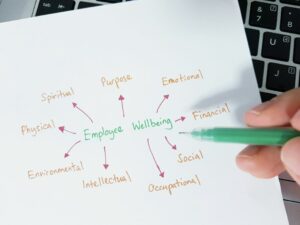Companies who support employee wellbeing could save billions. Healthista spoke to Angela Steel, Founder & CEO of SuperWellness, who provides advice on how companies can supercharge their staff
There are a plethora of statistics showing why workplace wellbeing should be a high priority for all employers.
Especially considering that research by Gov.uk reported that around 12.8 million (31%) of working age people in the UK have a long-term health condition.
It has also been estimated that 38.8 million working days are lost due to work-related ill health, according to The Health & Safety Executive, and according to Thriving at Work, this loss of work can lead to an annual cost to employers between £33 and 42 billion.
Employers who seek to support their staff benefit in many ways. The Chartered Institute for Personnel Development (CIPD) wellbeing report 2022, reported that organisations which have a workplace wellbeing strategy in place, were at least twice as successful at lowering sickness absence, improving morale and engagement.
organisations which have a workplace wellbeing strategy in place, were at least twice as successful at lowering sickness absence
The report also showed that those organisations were also more than five times more successful in improving productivity and more than three times more successful at retaining staff than those who didn’t.
Sick leave varies a lot from company to company – in some sectors, employees may not take sick days, but the problem is still there in a more insidious form: presenteeism (being at work when you’re sick).
The majority of sick leave is connected to stress, depression, anxiety and musculoskeletal disorders according to the HSE. With stress being such a huge factor, there is a strong link with difficult work environments.
One of the greatest barriers to employee wellbeing (identified by the latest CIPD report) is line manager skills – many line managers are ill-equipped to support employees who are struggling, or are unaware that their own behaviours may be impacting the mental health of their team.
READ MORE: Growth Mindset vs Fixed Mindset – which one leads to success?
Why is it important for employers to invest in their employees?
Employees have higher expectations for their employer to look after their wellbeing than they might have done a few years ago. Employee wellbeing is now seen as a priority, especially by the younger generations coming into the workplace.
Whereas wellbeing and performance used to be perceived to be two separate (and maybe even competing) priorities, increasingly studies now show that the two are connected and that in fact investing in employee wellbeing in the right way can also result in increased performance, so it’s a win-win.
Wellbeing is now seen as a priority
My top tips to supercharge staff is to address the fundamentals first – create a work environment people enjoy being in, which provides them with a sense of purpose and connectedness.
Promote and support self-care – the power each of us has to support our own health and prevent illness, through access to knowledge and information, and encouragement to put habits that benefit us into practice.
And finally it’s good to inject some fun into work life – even workplace wellbeing initiatives can sometimes be perceived as heavy and off-putting for some, of course there are issues which require a serious and thoughtful approach but this needs to be balanced out by more light hearted messages and approaches too.
The most engaged and supercharged staff I’ve come across are those who feel cared for!
READ MORE: Menopause symptoms at work: Government rejects calls for ‘menopause leave’ – a note from the Editor
About SuperWellness…
At SuperWellness, our approach is specifically focused on empowering employees to improve physical and mental health through lifestyle.
We provide them with the knowledge and support to make informed choices when it comes to food, exercise and other aspects of daily life and to build long-term habits one step at a time, in a way that’s realistic and fits with a busy work life.
In practical terms, our programmes are delivered both online and in person and cover a wide range of topics such as sleep, women’s health, men’s health and more.
employees at a construction company we worked with saw a 30 per cent improvement in sleep
Over the years we’ve worked with a wide range of organisations who have reported strong benefits for themselves and their employees: for example employees at a construction company we worked with saw a 30 per cent improvement in sleep, a 13 per cent improvement in stress resilience and 10 per cent improved energy.
Employees at an accountancy firm, reported a 39 per cent increase in staff doing physical activity at least three times a week and an 18 per cent rise in employee wellbeing and happiness.
We also worked with a company in the transport sector, which saw huge improvements in sickness absence following one of our programmes, from 7 per cent dropping down to just 0.07 per cent.
READ MORE: HIIT or Quit? Why the well-known HIIT workout is falling out of favour
Physical Wellbeing at Work
A report by ESRC in 2020 showed that individuals who had been diagnosed with a chronic physical health problem and those who engage in risky health behaviours (e.g. smoking, unhealthy diet, lack of exercise) showed reduced productivity.
Imagine the impact when you think about the effect of a high carb lunch on energy levels for example, if you consider it affects your concentration and energy for at least one of two hours in the afternoon and multiplied across hundreds of employees how much this single aspect could be costing an employer.
How can companies support their staff’s physical wellbeing?
Firstly by creating an environment that supports physical wellbeing – from the workstation setup to staff canteens which offer healthy options (particularly in workplaces with limited options to go out and buy food, shift work or jobs with very limited and short breaks).
Secondly, there’s a huge opportunity for employers to support education around healthy lifestyle and habits – in a non-judgemental, non-preachy way I hasten to add (and this is key to success).
there’s a huge opportunity for employers to support education around healthy lifestyle and habits
Everyone engages with information in different ways – for some, attending a really inspiring webinar on healthy eating might spark an interest to try out new recipes and start meal planning, or a step challenge organised by their employer might encourage some to start lunchtime walking clubs (with the added social benefit).
We carry out body composition testing with some of our clients and having a personalised test result such as metabolic age, along with tailored and relevant advice for straightforward adjustments (e.g. simply adding a little more protein with breakfast) can spur on incredible changes and transformations in some people.
READ MORE: ‘Ditch FAD diets’ says Dr Michael Mosley – plus 7 healthy recipes for the New Year
How can employers support mood and energy levels?
Again the work environment is the first priority – looking at work practices and addressing those that sap people’s energy: unrealistic expectations, lack of feedback and support, relentless workload – all of these things are the fundamentals.
In practice this means running staff surveys to identify problems, training managers to support employee wellbeing, having a wellbeing strategy in place which promotes values such as empathy, kindness, fairness… as well as principles of self-care and work-life-balance. These will all contribute to more engaged employees, who are happier and more energised.
ncouraging employees to take regular breaks in their day
In addition to this, employers can provide access to knowledge and support around healthy habits which can make an immediate difference to energy and mood – practical tips around nutrition, how to avoid mid-morning and mid-afternoon energy slumps for example.
With all the time we spend in front of our screens now, with back to back online meetings, another important area is breaks, and encouraging employees to take regular breaks in their day as well as switching off properly outside of work hours.
They can share practical tips about stretches and desk exercises to keep people energised with movement breaks.
READ MORE: Artificial intelligence – women are becoming AI tech savvy when it comes to their health
How can employers support female staff with menopause/menstrual issues?
Education is key here, to build an understanding of the experience of menopause and menstrual issues, so that managers and colleagues respond with empathy rather than embarrassment.
Thankfully there has been sweeping change in recent years, with growing awareness around these issues – for example the fact that almost a quarter of women leave their jobs due to symptoms they suffer during the menopause, such as poor sleep, anxiety and memory issues.
Employers can also provide practical support to women to better understand and address these symptoms through lifestyle measures such as diet, exercise and other self-care practices.
The Healthista Menopause Pack is a fully comprehensive online video workshop, led by Dr Dawn Harper; affordable, accessible and covering all aspects of the menopause, for those who need it most.
With expert advice and information from seven credible menopause industry experts, this online resource will help women navigate common health and wellness changes and challenges they may experience before, after and during the menopause.
Mental Health at Work
One in seven people experience mental health problems at work according to the Mental Health Foundation.
Companies have a duty of care towards their employees, in particular where the work itself could be placing a heavy stress burden on employees.
When companies fail to support employees’ mental health, it can affect the organisation in different ways
The health and safety executive considers psychosocial risk factors such as workload, or micromanaging bosses as being sources of stress which employers have a responsibility to monitor and address.
When companies fail to support employees’ mental health, it can affect the organisation in different ways, from a reputational cost (see some of the recent stories which hit the headlines and very public naming of employers on social media), to legal implications if employers fail to protect staff.
The ramifications can be huge in the current climate of competition for talent, where companies are vying to be ‘employers of choice’ to attract and retain talent in order to have/keep their competitive edge on the market.
How can employers support staff with mental health issues?
Firstly it’s important to create an environment which is psychologically safe for employees, meaning that people can speak up without negative repercussions such as shame or punishment.
Managers should encourage team members to speak openly if they’re struggling or having a bad day. It can be as simple as asking ‘how are you?’ and listening with empathy.
Both employers and employees must take responsibility for good mental health, and It’s also helpful to promote self-care – meaning that each of us feels equipped and able to make choices which support good mental wellbeing.
Both employers and employees must take responsibility for good mental health
Work-life balance is a good example of this, where remote work can bleed into times we would usually take to rest and recuperate. In this case, self-care would be about building in buffers between meetings or negotiating a more realistic work deadline for example.
READ MORE: Children’s mental health – child psychotherapist reveals key signs to look out for
How can employers support staff who feel lonely?
Social wellbeing became an important pillar of workplace wellbeing during the pandemic and has remained so. Remote and hybrid working for all of their benefits have also increased issues of isolation, and employers need to purposefully build in social connection into work life.
This starts with managers checking in with staff on a regular basis, looking out for signs that someone might be lonely or suffering from mental health issues.
Employee wellbeing initiatives should also factor in social elements which bring people together, for example friendly competitions and challenges, group activities and discussions (even when done remotely) can create a sense of not being alone.
Angela Steel started SuperWellness in 2011. She went on to win an Entrepreneur of the Year award and caught the attention of the corporate sector who liked her employee wellbeing programmes, nutrition workshops and team challenges.
Today SuperWellness are the leading provider of nutrition-centred wellbeing services in the UK.
Clients include Vitality, Network Rail, AmcoGiffen, Harrods, The National Oceanography Centre, HSBC, PwC, The London Stock Exchange, Visa and many more.
SuperWellness results regularly surprise companies, who quickly discover the measurable impact such investments have on their reputation and the business’s performance, morale, turnover and profits.
Like this article? Sign up to our newsletter to get more articles like this delivered straight to your inbox.




























































